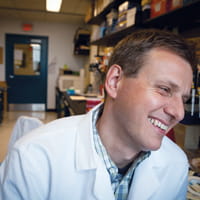Molecular Mavericks
Scientists break through limitations, discover new possibilities to overcome disease
One study counters accepted scientific dogma — unlocking new clues to the health problems people face in old age.
Another describes a new drug candidate that could control disease-fueling cell inflammation, with enormous potential for battling disease.
And a third suggests a therapeutic approach that could improve survival for children with acute myeloid leukemia (AML) with less toxicity to healthy cells.
These are a few research highlights from the past year for the Division of Experimental Hematology and Cancer Biology, as its scientists continue to make bold inroads into uncharted scientific territory.
“We continue to publish novel findings that take on some current controversies and unmet challenges in life sciences,” explains Yi Zheng, PhD, division Director and a collaborator on the studies. “Our goal is clear — to work with physicians and clinical researchers to translate what we learn from these bench-side studies to improve the clinical care of patients with deadly diseases, like cancer.”
Picking Nature’s Lock
 |
Dr. Hartmut Geiger’s laboratories at Cincinnati Children’s and the University of Ulm School of Medicine in Germany have unlocked scientists’ understanding of cellular aging. |
Prevailing scientific literature said it could not be done. The aging of hematopoietic stem cells (HSCs) in the bone marrow — the body’s blood making factory — was locked in by nature and irreversible.
Then a team of scientists at Cincinnati Children’s and Ulm University School of Medicine in Germany — led by hematology researcher Hartmut Geiger, PhD — published a study this spring in Cell Stem Cell showing they had done “it.”
The researchers used a substance called CASIN to pharmacologically inhibit the activity of a protein that regulates cell signaling (Cdc42) and rejuvenated aged HSCs to become functionally younger.
“The findings are novel and significantly advance this field of study,” says Geiger, a scientist and faculty member at Cincinnati Children’s and the University of Ulm. “They also span a wide arc — from the initial identification of a molecular pathway’s relevance to successful pharmacological targeting and rejuvenation of HSCs.”
Geiger noted the study also bridges several areas of research previously considered unrelated — Cdc42 signaling, epigenetic cell polarity, aging and stem cell rejuvenation.
WHAT IS IT? APPLICATION EXPANDED USE |
If the findings can be translated to humans, the implications would be considerable. HSCs produce blood cells that are critical components of the immune system. Rejuvenating aging stem cells could lead to reinvigorating the faltering immune systems of older people, making them less susceptible to infections, anemia and certain kinds of malignancies.
The findings also may extend to childhood cancers, according to Zheng and Geiger. Disruptions in cell polarity — the relative placement and spacing of vital cellular components — are suspected of playing a role in certain cancers. Understanding the molecular reasons for disruptions in cell polarity and how to resolve them — an area of study Zheng says is just emerging — could benefit children with certain cancers.
Similarly, Cdc42 protein activity is abnormally high in numerous cancers — a focal point of Zheng’s research for years. New knowledge on the protein’s activity, and how to manipulate it, will help future cancer research.
All Fired Up
Inflammation’s role in the disease process is an important part of the cancer research team’s work.
“Inflammation has recently been implicated as a key helper or modifier of many diseases, including cancer,” explains Zheng. “Effective anti-inflammation agents that do not cause unwanted toxicity could certainly help control and suppress inflammation, and would therefore be therapeutic in inflammation-assisted diseases, like cancer and obesity. This remains an unmet clinical need.”
The body requires inflammation to fight pathogens, but only to a certain extent. A virtual mountain of research shows that excess and chronic inflammation can generate biological havoc on the human body.
Past efforts to find new drugs that tamp down so-called reactive oxygen species (ROS) molecules in cells —which help fuel inflammation — have been complicated by toxicity issues and a lack of specificity in how molecular processes are targeted. But Zheng and his colleagues — including division collaborator Marie-Dominique Filippi, PhD — published a study in Chemistry & Biology that reported the scientists had overcome this problem.
Using computer-assisted drug design — verified by laboratory tests on human and mouse inflammatory cells — the researchers designed two versions of a small molecule inhibitor they named Phox-11 and Phox-12. The inhibitors precisely target and block the molecular binding of a signal sensor for ROS with an inflammation protein called p67-phox — hence the name of the new compounds.
Less Inflammation, No Toxicity
The new compounds convincingly demonstrated the ability to tamp down disease-fueling inflammation in the cells of mouse models of pulmonary disease without being toxic. As a result, Phox11 and 12 have been transferred into a technology commercialization research and development phase through the Center for Technology Commercialization at Cincinnati Children’s.
Zheng says the drugs may benefit people suffering from a variety of diseases, including chronic obstructive pulmonary disease, ischemia-induced lung and brain damage and hypertension, among others.
Double Teaming Leukemia
Nearly half of children with acute myeloid leukemia (AML) die from relapsed or refractory disease, despite current treatments using the maximum doses tolerated safely by patients. Those stark odds highlight the need for new and improved targeted treatments, according to division scientist James Mulloy, PhD.
One problematic form of AML — responsible for a significant number of cases — is mixed-lineage leukemia (MLL) associated with a chromosome abnormality involving a gene called AF9.
A study by Mulloy and colleagues — published November 2011 in the journal Blood — describes how the scientists double teamed and stopped this type of AML in mice by using gene targeting to block a protein pathway that drives the onset and growth of AML. The experimental combination therapy included a small-molecule inhibitor developed at Cincinnati Children’s called NSC23766.
The targeted pathway involves the Rac protein family — part of a class of proteins known as Rho GTPases. Rho GTPases coordinate a variety of functions in hematopoietic cells — migration, cytoskeleton rearrangements, proliferation and survival. Rac signaling also regulates cell functions in initiating and spreading hematopoietic cancers. The second component of the targeted pathway involves the protein family Bcl-2, which regulates cell apoptosis — or programmed cell death.
Building on extensive previous research, the scientists disrupted the anti-apoptotic function of Bcl-2 proteins in the mice. The researchers then added NSC23766 to the treatment regimen to further block Rac activation in the leukemic cells. This combination treatment was highly effective in targeting the survival of leukemic cells in AML.
The researchers also found this therapeutic approach does not harm healthy blood cells in mice, suggesting it might be less toxic to patients if further developed for humans.




